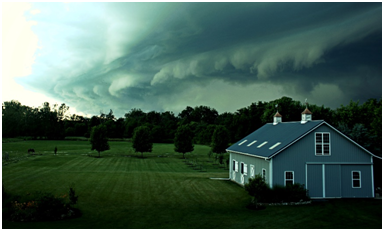Preparing Your Horse for Severe Weather
Sep 3rd 2019
 Severe weather can lead to a number of considerable problems
if you and your horse are not readily prepared. This means that a horse owner’s
best protection against adverse weather conditions lies within their own training
and experience. By following these tips and tricks, you can better learn how to
keep you and your horse safe and sound when severe weather strikes.
Severe weather can lead to a number of considerable problems
if you and your horse are not readily prepared. This means that a horse owner’s
best protection against adverse weather conditions lies within their own training
and experience. By following these tips and tricks, you can better learn how to
keep you and your horse safe and sound when severe weather strikes.
Developing a disaster plan is key to the safety of any horse. Understanding which types of severe weather threats are present in your area, as well as the steps that ought to be taken when those threats arise can be the deciding factor between a dangerous and a favorable situation.
All farm personnel should be familiar with your disaster plan - including evacuation routes, shelter locations, how to use emergency kits, etc. It is important to practice your emergency disaster plan on a regular basis in order to stay prepped and ready for the unpredictable.
Some necessary disaster planning steps include:
- Make sure your horse is up to date on vaccinations (particularly tetanus) and other basic health assessments.
- Make sure your horse is comfortable with loading on and off a trailer – as well as keeping trucks fueled and trailers in good maintenance in case evacuation is necessary.
- Make sure pastures are cleared of loose debris, hazardous items, and that fencing/holding areas are safely implemented and secured around the property.
- Have a surplus of water, hay, other feeds, and medications readily available (enough to get through at least 48 hours).
- Have a way to identify your horse: brand, tattoo, microchip, halter plates or tags with your name and number, etc.
- Ensure access to a portable radio and first-aid kit (make sure to check expiration dates and stock up on batteries).
- Incorporate lightning suppression systems, smoke detectors, sprinkler systems, and backup generators into high-risk buildings.
During the Storm
Severe weather can be frightening, especially for your horse. Taking your horse’s anxiety level into consideration during severe weather can help make the emergency disaster plan run more smoothly.
For instance, if a horse spends much of their time outdoors, they may react poorly when being placed in an enclosed environment during a storm. This may sound counter intuitive in terms of safety, but sometimes (depending on the severity of the weather) a small, semi-covered paddock is a better alternative for horses that are not accustomed to being stalled.
If flooding is a concern, it is important to ensure that your horse has access to plenty of clean drinking water. Consuming contaminated floodwater can lead to serious health issues such as gastrointestinal illnesses, dysentery, cholera, etc. So absolutely make sure your horse isn’t drinking it!
After the Storm
Even after a storm has passed, threats to your horse’s health may still be present. Knowing how to properly handle the aftermath of a severe weather storm can help keep your horse safe and secure.
Here are some things to think about:
- Check fences, paddocks, and pastures for damage and debris.
- Make sure all horses are accounted for and properly identified.
- Check hay and feed for mold growth (particularly after a flood).
- Restrict horses from access to flooded areas.
- Bathe your horse as soon as possible after a storm to prevent irritants and containment.
Owners play a very important role in keeping their animals safe during dangerous situations. Taking the necessary precautions and having a plan drawn out for when disasters strike can help ensure that you and your horse are prepared for any unpredictable circumstances.





